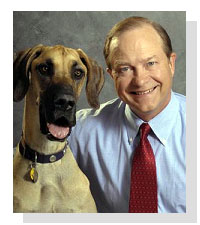Pet Podcasts
- Teacher's Pet
- Oh Behave !!
- Wings 'n Things
- The Pet Doctor
- Travel Tails
- Doggy Dog World
- Lucky's Stars
- Horsing Around
- PetLifeVideo
- Animals Speak
- Pet Peeves
- Cattitude
- Take Me Home
- Pets In The City
- Paranormal Pets
- The Pet Set
- PetTalk Naturally
- Hollywood Pets
- Lizard Lounge
- Off The Hook
- What Were
You Thinking
Check Out






Dr. Jim Humphries
President and News Director
Veterinary News Network

Pet Smiles Go High Tech!
 ......................................................................
......................................................................
We all know that our pets need good dental care. But did you know that even if your dog's mouth looks perfectly normal, there is a 28% chance that he has some dental issues? Crooked teeth and broken teeth are extremely common, not to mention painful and can make chewing difficult to impossible. Luckily, the Veterinary Dentist has an arsenal of tools to help fix your pet

For us, going to the dentist will often include services ranging from dental x-rays and whitening to repairing fractured teeth. As the human-animal bond continues to deepen, more pet owners want the same sort of service for their pets. And fixing their pet’s smile is a job for the Veterinary Dentist!
More than 85% of our pets will have dental disease by the time they are three years old. But many of our pets will also suffer from broken, diseased, or crooked teeth. For many years, extraction of the offending teeth was the typical solution to provide relief. Now, with the advent of digital dental x-ray machines, veterinarians and even special veterinary dentists can more accurately determine the health of the pet’s mouth and tailor a solution to save the pet’s teeth.
Dental x-rays are a common service for us when we visit the dentist. But our pets have not always been so lucky. The importance of dental x-rays cannot be overstated. Even if your pet’s mouth looks healthy, chances are that some sort of problem lies deeper.
According to Dr. Brett Beckman, President of the American Veterinary Dental Society, 42% of cats and 28% of dogs have hidden dental problems. Dr. Jan Bellows, a Diplomate in the American Veterinary Dental College agrees. “Sixty percent of the tooth lies under the gum line. Since companion animals don’t talk (to tell us where the pain is), x-rays help the veterinarian see what’s below.”
Normally, our canine friends should have 42 teeth. But, for many toy breed dogs and short-faced breeds, like Pugs, this number can cause crowding and mal-alignment. It is not uncommon to see a Shih Tzu or Yorkie with teeth that have rotated. Additionally, dogs with under-bites and over-bites also occur. All of these conditions can make it difficult, or even painful, for the pet to properly chew food. Dr. Bellows says “teeth that are mal-aligned are very common and can lead to a painful mouth if not treated by selective extractions, orthodontic tooth movement or crown reduction and restoration.” Yes, you read that right…braces for your pet!
Cats have their own special dental problem. Due to reasons that have not fully been determined, cats will often develop a painful erosion of tooth enamel called a cervical line lesion or neck lesion. As the normal enamel is lost, the pulp cavity of the tooth is exposed to the environment, causing painful stimulation of nerves. Extraction of the tooth is often the only solution.
Trauma to pet’s teeth is an everyday problem at the veterinary office and happens from a variety of means. Some pets will chew rocks or sticks and fracture their teeth, exposing the sensitive pulp cavity. Police dogs are at high risk for breaking the large canine teeth up front during their rigorous duties. Dr. Beckman reports that he has been able to save several of these broken teeth using restorative techniques and chrome/nickel crowns, allowing the canine officer to return to his duties and, of course, brag to his buddies. Most dental experts agree that if the fractured tooth is healthy, pet owners should allow their veterinary dentist to perform a root canal and restore the tooth rather than simply extract it.
Even teeth suffering from advanced periodontal disease may be saved with the combination of right owner, cooperative pet and the veterinary dental team. Veterinary oral surgery is now on the rise as pet owners do whatever they can for their four-legged friends. After oral surgery, the at-home care of the patient is vital to the recovery and the success of the procedure. Without a compliant pet and a committed owner, the chances for saving the teeth are greatly diminished and extraction of those teeth may be the better option. Dr. Bellows’ website, www.dentalvet.com, describes many of these oral surgeries.
The use of a newly developed barrier sealant is another high-tech, but low cost method to help keep your pet’s mouth healthy. Oravet® is a specially designed gel that actually adheres to the tooth surface and repels plaque forming bacteria. In just one minute per week, you can now minimize the accumulation of plaque and tartar build-up.
It takes a whole team to help keep your pet’s smile healthy. Talk with your family veterinarian and ask if dental radiographs are available in your area. Find out what at-home dental products are recommended by your veterinarian and be sure to use them routinely.




